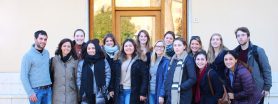 Along with warmer days hinting at spring, the end of February brings Italy’s best truffle producers to the small Umbrian town of Norcia. Umbra student Amy Huang made the trip up and around ambling hills to sample the famous and rare mushroom, and had this to say about the undeniably tasty experience.
Along with warmer days hinting at spring, the end of February brings Italy’s best truffle producers to the small Umbrian town of Norcia. Umbra student Amy Huang made the trip up and around ambling hills to sample the famous and rare mushroom, and had this to say about the undeniably tasty experience.
Going to Norcia was somewhat of a fluke. I learned from the “Umbra Day Trips” guides at Umbra I that Norcia has a black truffles festival at the end of February and was dismayed to discover that the festival was the same weekend as the start of spring break. Luckily, it turns out that the festival takes place over two weekends: the last weekend of February and the first weekend of March.
Known as the Mostra Mercato del Tartufo Nero, Norcia’s annual black truffles market showcases a range of regional products that includes olive oil, wine, sausages, salami, and, of course, black truffle, the expensive mushroom used in preparing many typical Umbrian dishes. Norcia is especially known for its truffles and its salami. Most of us here in Perugia are also familiar with delicious pasta dishes prepared alla norcina, pasta served with a white creamy sauce made with sausage and truffles. Norcia’s black truffles market drew Italians from all over Umbria, most of whom drove to the little town located in the midst of the beautiful Valnerina valley. My two friends and I took the train to Spoleto and then from there took a bus that swerved several times on a narrow road leading uphill.
products that includes olive oil, wine, sausages, salami, and, of course, black truffle, the expensive mushroom used in preparing many typical Umbrian dishes. Norcia is especially known for its truffles and its salami. Most of us here in Perugia are also familiar with delicious pasta dishes prepared alla norcina, pasta served with a white creamy sauce made with sausage and truffles. Norcia’s black truffles market drew Italians from all over Umbria, most of whom drove to the little town located in the midst of the beautiful Valnerina valley. My two friends and I took the train to Spoleto and then from there took a bus that swerved several times on a narrow road leading uphill.
The black truffles market took place in the town center, where vendors lining the main streets offered ample opportunities for tasting wine, cheese, olive oil, and cured meat. There were stands advertising organic produce from nearby agriturismos, as well as stands that sold products from other regions such as Abruzzo, Puglia, and Sicily. We sampled Sicilian pastries, ricotta salata with sweet sauces, and cheese, salami, and sausages made with truffles. I even tasted salame d’asino, a chewy type of salami made from Donkey meat that left a gross, ashyaftertaste.
We ended our day by grabbing a gelato at a café near the town center and watching the light of dusk settle on the snow-capped mountains that surrounded Norcia. The trip was fun but, getting home was frustrating because every car parked in Norcia decided to leave at the same time!











 elieve it or not, Italians have names for every wind.
elieve it or not, Italians have names for every wind.